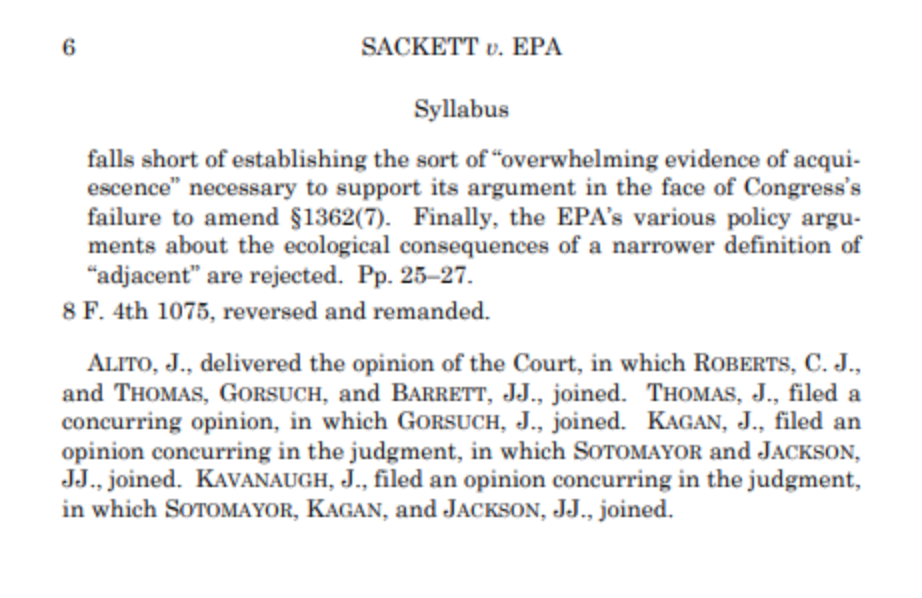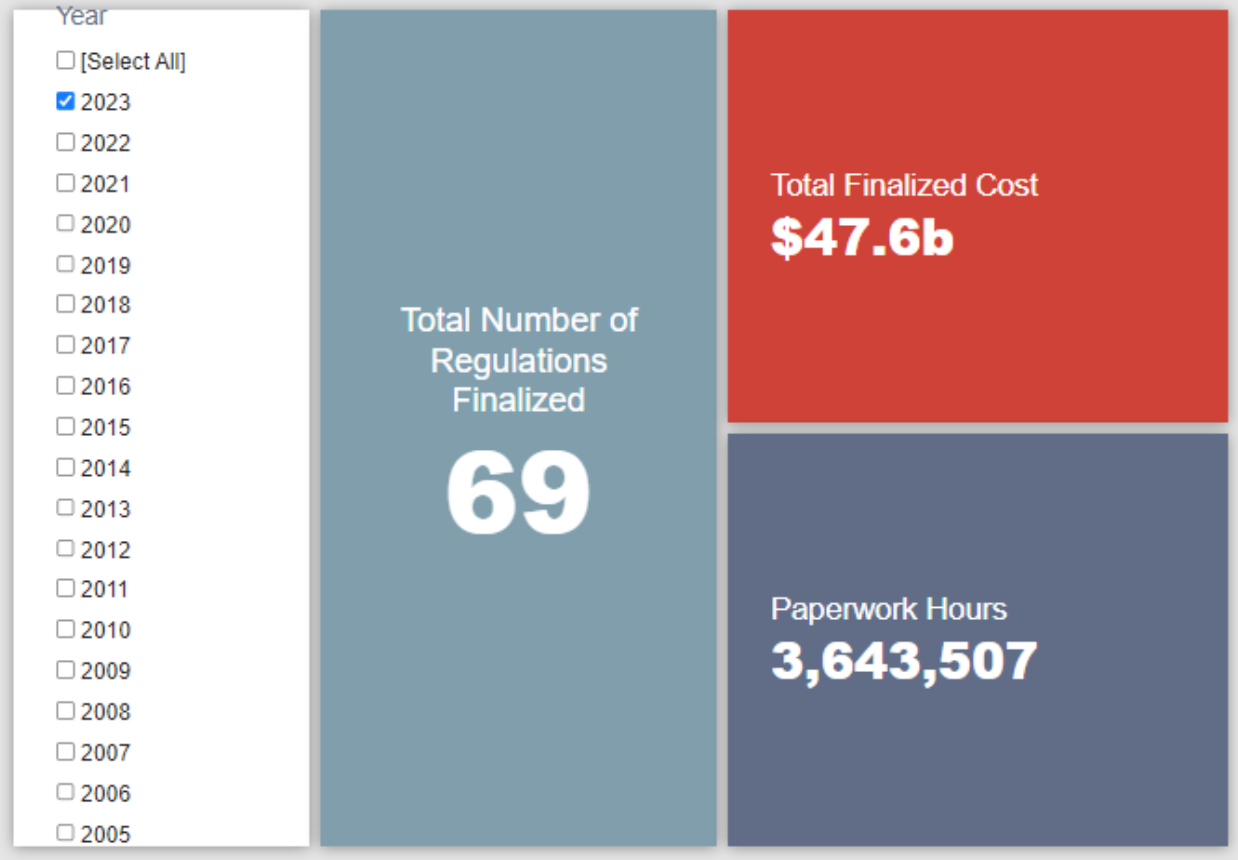Week in Regulation
May 30, 2023
A Wild Week for the EPA
Last week was a fairly busy one in the pages of the Federal Register with 13 rulemakings containing some measurable economic effect and two of them crossing the billion-dollar threshold. The “main character” of the week, however, was the Environmental Protection Agency (EPA). The agency hit a regulatory policy trifecta of sorts in: 1) having the most significant rulemaking of the week, 2) being the primary subject of the most high-profile Supreme Court case of the week, and 3) seeing one of its rules come up for a Congressional Review Act vote. Across all rulemakings, agencies published $12.4 billion in total costs and added 372,437 annual paperwork burden hours.
REGULATORY TOPLINES
- Proposed Rules: 42
- Final Rules: 62
- 2023 Total Pages: 34,350
- 2023 Final Rule Costs: $47.6 billion
- 2023 Proposed Rule Costs: $312.4 billion
NOTABLE REGULATORY ACTIONS
The most consequential rulemaking of the week was the proposed rule from EPA entitled “New Source Performance Standards for Greenhouse Gas [GHG] Emissions From New, Modified, and Reconstructed Fossil Fuel-Fired Electric Generating Units; Emission Guidelines for Greenhouse Gas Emissions From Existing Fossil Fuel-Fired Electric Generating Units; and Repeal of the Affordable Clean Energy Rule.” The rulemaking is essentially the Biden Administration’s redux version of the Obama-era “Clean Power Plan” (CPP). The regulation of GHG emissions from power plants has involved a long and tenuous legal history in recent years with the Supreme Court (more on it versus EPA later) officially striking down the core of the CPP last year in West Virginia v. EPA due to the lack of a clear legislative basis for that regulatory program.
Since many of the CPP’s issues are related to its somewhat complicated state-oriented framework, the Biden plan shifts gears toward more directly regulating plant-by-plant emissions. EPA currently estimates that the plan will involve roughly $10 billion in total costs. Under this new plan, EPA expects “technologies such as carbon capture and sequestration/storage, low-GHG hydrogen co-firing, and natural gas co-firing,” to play a major role in lowering emissions in coming years. Concerns remain, however, over the technical and financial feasibility of the real-world deployment of such technologies.
TRACKING THE ADMINISTRATIONS
As we have already seen from executive orders and memos, the Biden Administration will surely provide plenty of contrasts with the Trump Administration on the regulatory front. And while there is a general expectation that the current administration will seek to broadly restore Obama-esque regulatory actions, there will also be areas where it charts its own course. Since the AAF RegRodeo data extend back to 2005, it is possible to provide weekly updates on how the top-level trends of President Biden’s regulatory record track with those of his two most recent predecessors. The following table provides the cumulative totals of final rules containing some quantified economic impact from each administration through this point in their respective terms.
Despite there being only three final rules with some quantified economic impact last week, the Biden Administration’s total costs bumped up by roughly $2.1 billion. A Department of Energy rule setting efficiency standards for “Room Air Conditioners” provided most of that increase. In terms of the other two administrations, the most notable action happened under Trump’s watch. Trump-era costs and paperwork increased by roughly $1.1 billion and 652,000 hours, respectively. The administrative burdens imposed by a Department of Health & Human Services rule on “Protecting Statutory Conscience Rights in Health Care; Delegations of Authority” was the primary reason for that regulatory spike.
THIS WEEK’S REGULATORY PICTURE
This week, the Supreme Court (SCOTUS) hands down an important yet somewhat convoluted decision on an important yet somewhat convoluted issue: “The Waters of the United States” (WOTUS).
Source: Image pulled from SACKETT v. EPA Decision
As noted when SCOTUS first took on the case, the WOTUS issue has long been a winding and complex issue of agency authority. Last Thursday, SCOTUS finally released its 9-0 opinion of the Court that ruled in favor of the Sackett family in their long-running legal dispute with EPA (and, by extension, its partnering agency on this issue: the Army Corps of Engineers) over the issue of whether a patch of wetlands on their property constituted WOTUS. Yet as one can probably tell from the parade of concurrences pictured above, while the specific ruling on the narrow question of the Sacketts’ property’s status was unanimous, the broader policy issues raised were more muddied.
The main split was between the Justice Alito-authored opinion of the Court and the concurrence authored by Justice Kavanaugh and joined by Justices Sotomayor, Kagan, and Jackson. The main opinion of the Court finds in favor of the Sacketts because it rejects the EPA argument for a “significant nexus” connection between the wetlands in question and a nearby lake. The concurrence “majority,” however, also took the step of establishing a standard going forward – largely drawn from the 2006 WOTUS case, Rapanos – that a WOTUS designation must involve a “a continuous surface connection” between the geographic areas in question. The concurrence “minority” disagrees with this being the standard going forward, as noted in its conclusion thusly:
In sum, I agree with the Court’s decision not to adopt the “significant nexus” test for adjacent wetlands. I respectfully disagree, however, with the Court’s new “continuous surface connection” test. In my view, the Court’s new test is overly narrow and inconsistent with the Act’s coverage of adjacent wetlands. The Act covers adjacent wetlands, and a wetland is “adjacent” to a covered water (i) if the wetland is contiguous to or bordering a covered water, or (ii) if the wetland is separated from a covered water only by a man-made dike or barrier, natural river berm, beach dune, or the like. The wetlands on the Sacketts’ property do not fall into either of those categories and therefore are not covered under the Act as I would interpret it. Therefore, like the Court, I would reverse the judgment of the U. S. Court of Appeals for the Ninth Circuit and remand for further proceedings. But I respectfully concur only in the Court’s judgment.
So where does that leave everyone going forward? Citing the potential effects of the Trump-era WOTUS rule as a proxy, press reports point to “51 percent of wetlands” now falling outside of EPA protection, drawing the consternation of environmental advocates and the praise of potential stakeholders such as a farmers and construction companies. The Biden Administration plans to review its options in terms of further rulemaking on the issue. The standard set by this narrow “majority” decision, however, only covers a fairly specific set of circumstances contemplated in determining WOTUS status and largely hinges on a semantic dispute over the terms “adjacent” and “adjoining.” One can see the potential for a case in the future where the circumstances differ in such a way that the Court reaches a nominally different conclusion. Until Congress fully dives into these policy waters to more precisely clarify the terms involved and its legislative intent, though, the administrative and judicial tides of the WOTUS saga will continue to ebb and flow.
TOTAL BURDENS
Since January 1, the federal government has published $360.1 billion in total net costs (with $47.6 billion in new costs from finalized rules) and 53.2 million hours of net annual paperwork burden increases (with 3.6 million hours in increases from final rules).












